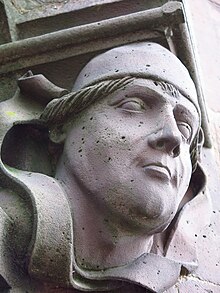
Hans Nussdorf was a late gothic architect known for having completed the Martins tower of the Basler Minster in 1500. He was also involved in the construction of the Bernese Munster and the St.Leonhards church in Basel.

Hans Nussdorf was a late gothic architect known for having completed the Martins tower of the Basler Minster in 1500. He was also involved in the construction of the Bernese Munster and the St.Leonhards church in Basel.
Where Nussdorf was born is not known, but it is assumed he hailed from Nussdorf at the Lake Constance. A Hannsen von Constentz or Hans von Constanz was mentioned in 1455 [1] to have constructed the Monkey's Fountain. [2] A certain "Hannsenn of Constantz, the new foreman" received some money It is assumed that Nussdorf (then called Johannes de Constancia) began to work at the Minster in 1467 in a leading position. [3] Since 1472 he was mentioned as Hans Nussdorf. [2]
He was admitted to the Spinnwetternzunft, (the stonemason trade union of Basel) in 1479. [4] Onwards he was called master and in the 1480s, Nussdorf had his own mason workshop. [4] According to the local guidelines, a master was allowed to take in only one apprentice. [4]
Nussdorf is mainly known as the architect who finalized the works at the Martins tower of the Basler Minster. [5] The towers construction was initiated in the 12th century, but had to undergo renovation after the 1356 earthquake in Basel. [5] That the Martinstower was to rise more, was assumingly only decided in 1414. [6] It was the year that a mason from Strassburg arrived in Basel to assess the towers fundaments for an eventual further rise of the tower. [5] In 1470 another mason inspected the fundaments of the tower who also approved a further rise of the tower. [6]
In 1488, Nussdorf presented his plans for the completion of the Martins tower to the city council which approved them. [7] The construction of the tower begun in 1489, the year is marked in stone. [6] In 1496 and before the last stage of the completion of the tower, several other master masons were invited to give their approval on the towers fundaments. They approved and on the 23 July 1500, its construction was completed with the addition of the finial on the top. [4] [8]
On the Martinstower there is a bust of about 40 cm, [5] which is strongly assumed to depict Nussdorf. [9] Beside's the bust, on the same working block of sandstone from Wiesental there is a masons sign to be seen. [9] He wears a leather cap under which some locks of hair are to be seen. [9] [5] The bust is hewn out of high quality stone and is located at the north-face of the tower, which is less affected by the weather. [9] According to the appointments of the Minster masonry, he worked also on the ceiling of the small cloister and the surrounding walls of the large cloister. [5]
As the master mason of the Minster, he was one of the best earning craftsman in Basel. [10] Master masons were only hired or promoted for larger projects such as the Martins tower. [11] The master mason also had his personal workbench in the masonry of the Minster. After some remarkable accomplishments, he would be awarded some presents such as a considerable amount of wine or cereals. [10]
Nussdorf had also been contracted to work on a church in Delémont in 1481, but was accused of not fulfilling the contract in 1485. [12] He defended himself by arguing he had an overload of work as also in 1481, he had been hired to be the master mason of the Leonhards church . [12] He doesn't appear to have worked on both of the churches and in the case of the Leonhards church he was replaced by the Austrian Hans Niessenberger in 1491. [12] Niessendorf then accused Nussdorf of having insulted him which lead to a trial before court. [12] Niessenberger wasn't able to finish his work at the Leonhards church and seemed to have died by 1493. [13] In 1496 Nussdorf returned to the Leonhard church under a detailed contract in which he was assured not to be held responsible for the eventual mistakes of his predecessors. [14] But the scholarship doesn't view Nussdorf as the main architect of the Leonhards church, as a considerable amount of its construction was done after Nussdorfs death in 1503. [15]
Nussdorf was closely related with the masons guild of Strassburg, which in 1497 held their reunion in Basel explicitly "due to its famous master". [16]
Nussdorf had to sons, Hans and Friedrich, who both also became stonemasons. [4] Hans left Basel and became involved in the construction of the Minster of Bern, while Friedrich stayed in Basel and built the baptismal font for the St.Peters church . [4] He had a brother Peter, with who he had a legal dispute over the care of their mother. Peter demanded Hans to fulfill his duties in taking care of her as agreed, and the court ordered Hans Nussdorf to do so. [17] After his death in 1503, his estate was divided into one third to his wife and two thirds for his children. [18] Between 1475 and 1480 he was provided with a place to live in the Augustines Alley, in a house owned by the Minsterworkshop. [18] In 1480 he bought the House Sonnenberg in the White Alley. [18] He also bought a wineyard near the Aeschen Square in 1490, but it didn't appear in the inventory of the testament. [18] In the tax registers between 1475 and 1481 Nussdorf appears as a man without any wealth to tax which is suggested to be because the special treatment the masons working at the Minster received. [16]

Ulm Minster is a Lutheran church located in Ulm, State of Baden-Württemberg (Germany). It is currently the tallest church in the world. The church is the fifth-tallest structure built before the 20th century, with a steeple measuring 161.53 metres.

Johannes Oporinus was a humanist printer in Basel.
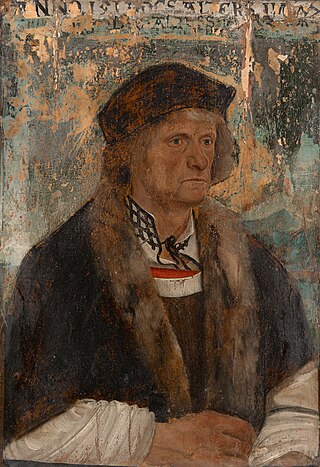
Johann Amerbach was a celebrated printer in Basel in the 15th century. He was the first printer in Basel to use the Roman type instead of Gothic and Italian and spared no expense in his art.
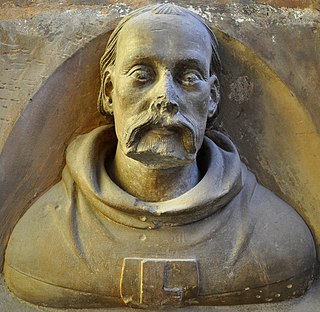
Peter Parler was a German-Bohemian architect and sculptor from the Parler family of master builders. Along with his father, Heinrich Parler, he is one of the most prominent and influential craftsmen of the Middle Ages. Born and apprenticed in the town of Schwäbisch Gmünd, Peter worked at several important late Medieval building sites, including Strasbourg, Cologne, and Nuremberg. After 1356 he lived in Prague, capital of the Kingdom of Bohemia and seat of the Holy Roman Empire, where he created his most famous works: St. Vitus Cathedral and the Charles Bridge.

Leonhard Ragaz (1868–1945) was a Swiss Reformed theologian and, with Hermann Kutter, one of the founders of religious socialism in Switzerland. He was influenced by Christoph Blumhardt. He was married to the feminist and peace activist Clara Ragaz-Nadig.

Flamboyant is a form of late Gothic architecture that developed in Europe in the Late Middle Ages and Renaissance, from around 1375 to the mid-16th century. It is characterized by double curves forming flame-like shapes in the bar-tracery, which give the style its name; by the multiplication of ornamental ribs in the vaults; and by the use of the arch in accolade. Ribs in Flamboyant tracery are recognizable by their flowing forms, which are influenced by the earlier curvilinear tracery of the Second Gothic styles. Very tall and narrow pointed arches and gables, particularly double-curved ogee arches, are common in buildings of the Flamboyant style. In most regions of Europe, Late Gothic styles like Flamboyant replaced the earlier Rayonnant style and other early variations.

Bern Minster is a Swiss Reformed cathedral in the old city of Bern, Switzerland. Built in the Gothic style, its construction started in 1421. Its tower, with a height of 100.6 m (330 ft), was only completed in 1893. It is the tallest cathedral in Switzerland and is a Cultural Property of National Significance.
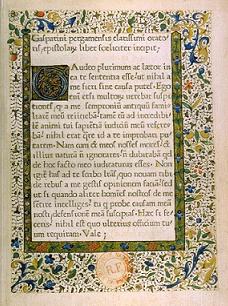
Johann Heynlin, variously spelled Heynlein, Henelyn, Henlin, Hélin, Hemlin, Hegelin, Steinlin; and translated as Jean à Lapide, Jean La Pierre , Johannes Lapideus, Johannes Lapidanus, Johannes de Lapide was a German-born scholar, humanist and theologian, who introduced the first printing press in France (Paris) in 1470.

Johann Parler the Younger, was a Bohemian architect of German origin from the prominent Parler family of architects, master builders, and sculptors. He was the son of famous Gothic architect Peter Parler, the builder of Saint Vitus Cathedral and Charles Bridge in Prague. His uncle was Johannes von Gmünd also known as Johann Parler the Elder, a German Gothic master builder who was architect of Freiburg Minster and also rebuilt the damaged Basel Minster.

Benjamin "Beni" Huggel is a Swiss former footballer who played as a midfielder for FC Basel in the Swiss Super League and for Eintracht Frankfurt in the Bundesliga.

Erwin von Steinbach was a German architect, and was a central figure in the construction of the Strasbourg Cathedral.
Louis Crayton is a Liberian former footballer.

Basel Minster is a religious building in the Swiss city of Basel, originally a Catholic cathedral and today a Reformed Protestant church.
The decade of the 1480s in art involved some significant events.

Melchior Berri was a well-known Swiss architect.
Hans Niessenberger was an architect of the latter part of the Middle Ages.

Guido de Monte Rochen or Guy de Montrocher was a French priest and jurist who was active around 1331. He is best known as the author of Manipulus curatorum, a handbook for parish priests, that was often copied, with some 180 complete or partial manuscripts surviving, and later reprinted throughout Europe in the next 200 years, with at least 119 printings, and sales which have been estimated to be three times those of Thomas Aquinas' Summa Theologica. It became obsolete only when the Council of Trent created the Roman Catechism in 1566.
The 2003–04 season was Fussball Club Basel 1893's 111th in existence and the club's 10th consecutive season in the Nationalliga A, the top flight of Swiss football. Basel played their home games in the newly constructed St. Jakob-Park complex. Local businessman Werner Edelmann was the club's chairman for the second consecutive season.

Oswald "Osi" Inglin is a Swiss politician and historian.
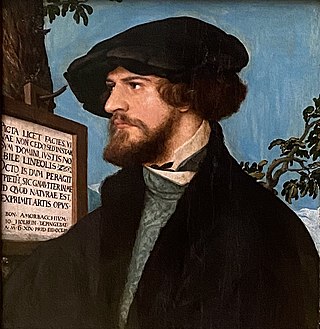
The Portrait of Bonifacius Amerbach is a painting by the German master of the Renaissance Hans Holbein the Younger. It is deposited in the Basler Kunstmuseum as part of the Amerbach Cabinet. It is painted in tempera on pinewood and measures 29 cm x 27 cm.